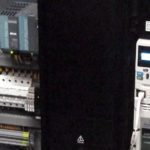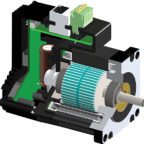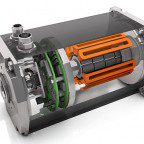Stepper drives and motors can integrate into one unit. Manufacturers supply various combinations of integrated stepper motor-drive combinations. These integrated stepper and drive units have their advantages and drawbacks. The benefits of the integrated motor and drive units include ease of implementation, reduced wiring complexity, faster setup and construction of a system and guaranteed motor-drive compatibility. Additionally, integrated units that incorporate systems on a chip (SoC) are also available. Read FAQ: What are motion-control systems on a chip for stepper motor control? for more on this.
Disadvantages include reduced configuration options, lack of customizability and potential vendor lock-in. Along with these come troubleshooting concerns and changes to maintenance practices.
An easy implementation is perhaps the most notable advantage of integrated drive-motor units. They require no wiring between drive and motor and can simply be “dropped” into place and connected to a controller. This means faster setup to allow a system to go from blueprints to production in a short amount of time.
Reduced wiring complexity means engineers do not have to worry about connecting inputs and outputs correctly between drive and motor.
Unipolar or bipolar wiring considerations are no longer a concern. There is no degradation in signal because of long wiring runs, either.

Integrated drives also mean guaranteed motor and drive compatibility. Since they are supplied together by the manufacturer, they are sure to work together. This means reduced work when looking at torque-speed curves, as the curves already account for the drive. There is no need to worry about whether the drive supplies the right kind of microstepping signals or uses the correct voltages, for example, as this is all taken care of. If the integrated unit comes with an SoC, then even more simplicity is possible. The SoC can take care of most control operations. Along with this, the combined unit is now able to connect to others, which is especially useful in the Internet of Things.
The primary disadvantage to such a setup is a lack of implementation flexibility and customization. Because the drive-motor combination comes as one unit, it usually works for only some applications and not others. Additionally, if changes to the driver are needed, but the motor is fine, or vice-versa, there is no choice but to replace the whole unit.
Customizability is limited because manufacturers usually do not have the level of optimization and specialization available for separate components available for integrated units. As such any unique or unusual requirements, a system has cannot be addressed.
Furthermore, if only one drive is needed but multiple motors are, integrated drives just introduce unneeded redundancy into the system. Additional drawbacks include vendor lock-in and changes in maintenance procedures, as it may be hard to tell whether a fault is due to the motor or drive.






Leave a Reply
You must be logged in to post a comment.